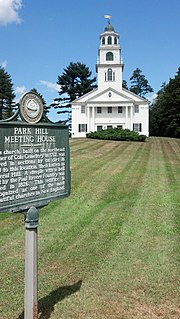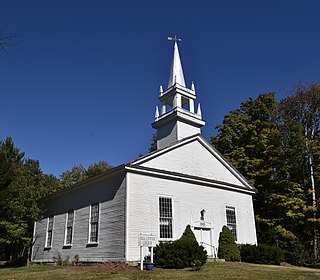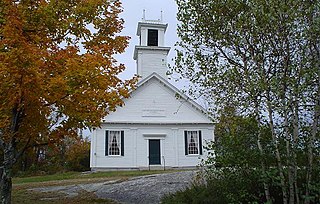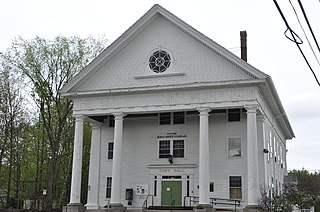
The Addison Community Baptist Church is a historic church building at 4970 Vermont Route 22A in the village center of Addison, Vermont. Built in 1816 and restyled in 1849, it is one of Vermont's oldest Baptist churches, and a good local example of Greek Revival architecture. It was listed on the National Register of Historic Places in 1978 as Addison Baptist Church.

The Francestown Meetinghouse is a historic meeting house on Route 136 in the center of Francestown, New Hampshire. The white clapboarded building was built c. 1801-03, and rebuilt in 1837, at which time it received its Greek Revival styling. It was used as a church until 1987, and for town meetings until 1833. The building was listed on the National Register of Historic Places in 1999. It is now managed by a nonprofit as a community resource.

The Canaan Meetinghouse is a historic meeting house on Canaan Street in Canaan, New Hampshire. Built in 1794, with some subsequent alterations, it is a good example of a Federal period meeting house, serving as a center of town civic and religious activity for many years. The building was listed on the National Register of Historic Places in 1972, and included in the Canaan Street Historic District the following year. The building is still owned by the town, and is available for rent.

The Park Hill Meetinghouse is a historic meeting house on Park Hill in Westmoreland, New Hampshire. Built in 1764, and extensively restyled in the early 19th century, it is a fine example of Federal and Greek Revival architecture, influenced by the work of regionally prominent architect Elias Carter. The building was listed on the National Register of Historic Places in 1980. It is now owned by the Westmoreland Park Hill Meetinghouse and Historical Society.

The United Church of Christ in Keene is a historic Congregational church at 23 Central Square in Keene, New Hampshire, United States. First built in 1786, and then moved and restyled in the 19th century, it is a prominent visual and architectural landmark in downtown Keene. The church and its adjacent parish house were listed on the National Register of Historic Places in 1982.

The First Congregational Church is a historic church building at 20 Church Street in Alton, New Hampshire, United States. Built in 1853-54, it is one of Belknap County's finest Greek Revival churches. The building was listed on the National Register of Historic Places in 1990.

The New Hampton Community Church, formerly known as New Hampton Village Free Will Baptist Church, is a historic church on Main Street in New Hampton, New Hampshire. It is currently associated with the American Baptist denomination. Built about 1854, it is a prominent local example of Greek Revival architecture, and was listed on the National Register of Historic Places in 1985.

The Union Church is a historic church on South Main Street in South Wolfeboro, New Hampshire. Built in 1845 for the use of several small religious congregations, it is a well-preserved example of mid-19th century vernacular Greek Revival architecture. The building was listed on the National Register of Historic Places in 1982.

The Center Meetinghouse is a historic meetinghouse on NH 103 in Newbury, New Hampshire. The Federal-style church building was built c. 1832, a relatively late date for the style. It replaced a 1797 meetinghouse that had been located about a mile away. It is further believed to be distinctive in New Hampshire as the only Federal period church in which the pulpit is located at the rear of the auditorium. Originally built to be used by multiple religious denominations, it is now operated by a local nonprofit organization as a community center. It was listed on the National Register of Historic Places in 1979.

The First Congregational Church of Boscawen is a historic church at 12 High Street in Boscawen, New Hampshire. Built in 1799, the wood frame church was significantly altered in 1839, when it acquired its present Greek Revival character. It is one of the few surviving meeting houses in New Hampshire that continues to combine religious and municipal functions; it basement space is used for town meetings and elections. The building was listed on the National Register of Historic Places in 1982.

The Hill Center Church is a historic church on Murray Hill Road in Hill, New Hampshire. Built in 1799 and extensively altered in 1847, it is a well-preserved example of Gothic Revival architecture, used historically for both religious and civic functions in the town. Now maintained by a local community group, the building was listed on the National Register of Historic Places in 1985.

South Parish is the historic name of a church at 292 State Street in Portsmouth, New Hampshire, in the United States. The church building, built in 1824-26, is one of the earliest examples of Classical Revival architecture in New England, and was listed on the National Register of Historic Places in 1979.

The Unitarian Church is a historic American church on Exeter Road in Hampton Falls, New Hampshire. Built in 1838, it is a rare example of an in antes Greek Revival temple front in the state, and is distinguished by the presence of Victorian trompe-l'œil panels and ribbing on its interior walls. The church was listed on the National Register of Historic Places in 1984. It is presently used for services in the summertime.

The Free Will Baptist Church is a historic church on Ridge Road in New Durham, New Hampshire. Built in 1819, it is considered the mother church of the Free Will Baptist movement, although it was not built until ten years after the death of founder Benjamin Randall. New Durham is where Randall rose to prominence, and where the church's teachings and governance were organized in 1780. The building was listed on the National Register of Historic Places in 1980.

Stockton Springs Community Church, formerly the Stockton Springs Universalist Church, is a historic church at 20 Church Street in Stockton Springs, Maine. Built in 1853, it is a fine example of transitional Greek Revival-Italianate architecture, and is particularly noted for the trompe-l'œil frescoes on its walls. It was listed on the National Register of Historic Places in 1985.

The Dorchester Common Historic District encompasses three public buildings that front the public common in the village of Dorchester, New Hampshire. The oldest of the three buildings is the schoolhouse, which dates to 1808 and is now a local museum. The Dorchester Community Church was built in 1828, and the town hall in 1844, on the site of the town's first (1828) town hall. The district was listed on the National Register of Historic Places in 1985; the church was also separately listed in 1980.

The Bedford Town Hall is located at 70 Bedford Center Road in Bedford, New Hampshire. Built in 1910, it is a prominent early work of Chase R. Whitcher, a noted architect of northern New England in the early 20th century. The building is the third town hall to stand on this site, and was listed on the National Register of Historic Places in 1984.

The New Ipswich Town Hall is a historic academic and civic building on Main Street in the center village of New Ipswich, New Hampshire. The 1-1/2 story wood frame structure was built in 1817 to serve the dual purpose of providing a town meeting place, and to provide space for a private academy. The building has been little altered since 1869, when it was substantially reconfigured solely for town use. The building was listed on the National Register of Historic Places in 1984.

The Deerfield Town House is the town hall of Deerfield, New Hampshire. Built in 1856, it is one of the state's finest examples of public Greek Revival architecture. The building was listed on the National Register of Historic Places in 1980, as "Town House".

The Huntington Lower Village Church, also known historically as the Huntington Union Meeting House, is a historic church building at 2156 Main Road in Huntington, Vermont. Built in 1870, it is a fine late example of Greek Revival architecture. It now houses the Huntington Public Library and serves as a community center. It was listed on the National Register of Historic Places in 1984.























